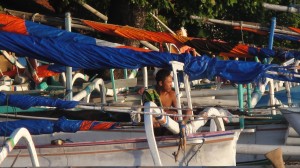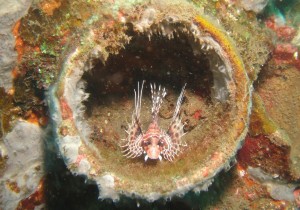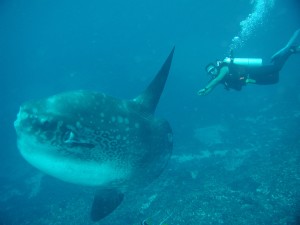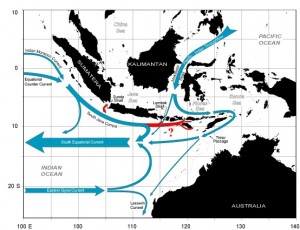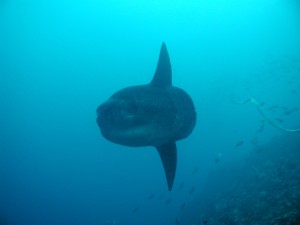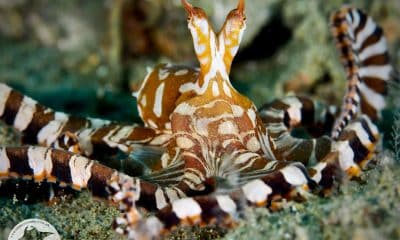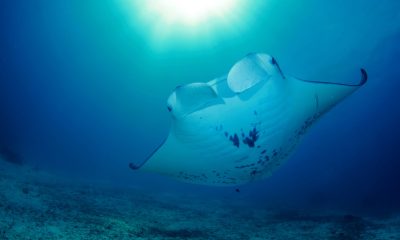Travel Stories
The Indonesian Throughflow
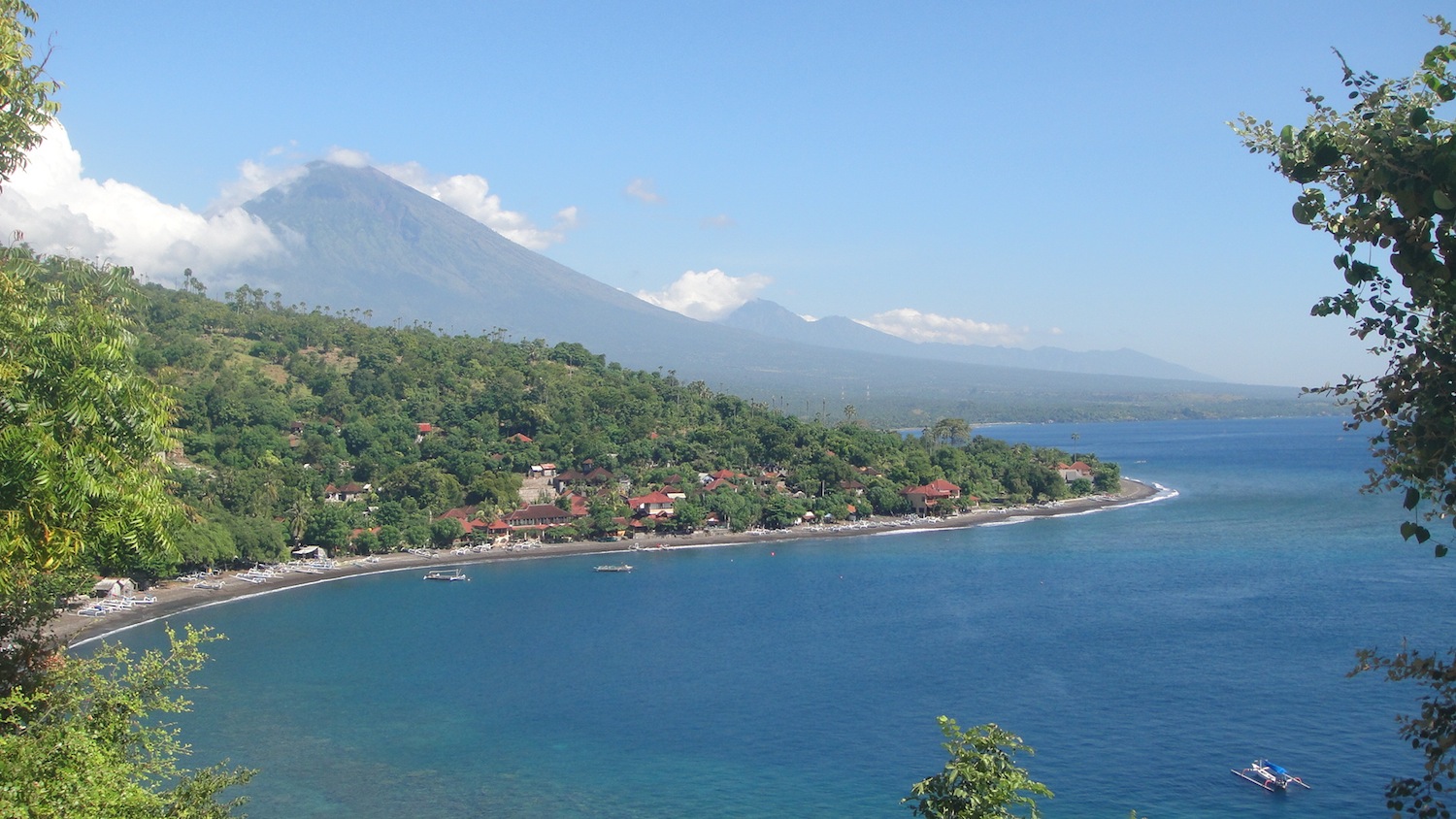
As you head out from the shores of east Bali on your morning dive you are surrounded by a host of tiny outrigger fishing boats, their sails flashing in the sunlight as they dance over the waves. It is a unique, entrancing and inspiring sight, all the more so because this is a very special place.
These fishermen (and you in your dive boat) are scudding over waters that lie on the cusp of geological and biological change. In the past, at times of low sea levels, this coastline marked the very tip of a massive Eurasian Continent. During those periods you could have walked all the way from Bali to Paris without getting your feet wet. However, even when the world’s oceans were at their lowest ebb, you could never have gone any further east without harnessing wind or mechanical power, due to the depth of the chasm between Bali and Lombok, the next island in the chain.
Wallace’s Genius
In the 19th century the great naturalist Alfred Russel Wallace spent time in the islands of what is now Indonesia and remarked on how different the species of bird and animal living in the west of the archipelago were from those that inhabited the east. His findings led him to draw a line on a chart that ran through the Makassar Straits between Borneo and Sulawesi, crossed the Banda Sea and continued down through the straits between Bali and Lombok. To the west of the line, in Bali, Borneo and beyond, animal and bird life was predominantly Asian. On the other side of the line, in Lombok, Sulawesi and further east, the animals and birds were strikingly different, mainly species that originated in or resembled those found in New Guinea or Australia. Brilliantly, he deduced that the reason was geological rather than biological: “I believe the western part to be a separated portion of continental Asia, the eastern the fragmentary prolongation of a former Pacific continent.” Of course, we now know that he was absolutely right!
During his trip Wallace also came up with the notion that natural selection was the driving force behind evolution. At the same time Charles Darwin was on the Beagle sailing the seas on the other side of the Pacific and drawing similar conclusions. But that is an entirely different story.
A Very, Very Big River
What Wallace could not know, in fact something that no-one noted until almost 100 years later, was that one of the factors preventing species crossing Wallace’s Line was an enormous moving body of water. The fossil and historical records show that elephants, orang-utans, bears, tigers and other Asian mammals never managed to bridge the gap. They got as far as Borneo and Bali but no further. Even those animals that tried to swim over or were caught on driftwood after a flood could never make the crossing as everything that enters the water on one side of the line is swept away far from land long before it can reach the other side.
In the Pacific Ocean to the northeast of the Indonesian archipelago, the sea level is about 20 centimetres above average. In the Indian Ocean south of Indonesia the sea level is 10 centimetres below average. This 30-centimetre drop between the oceans creates water movement on a massive scale, a phenomenon variously known as the Indonesian Throughflow or Pacific – Indian Throughflow. The most direct path between the oceans and the path taken by a large portion of the Throughflow, as you may have guessed, runs right along the Wallace Line between Borneo and Sulawesi then down through the straits between Bali and Lombok.
Visualise it as a very, very big river pouring through a canyon between continents. How big? Ocean current flows are measured in units called Sverdrups with one Sverdrup being 1 million cubic metres of water per second moving past a given point. The flow of the Amazon is about half a Sverdrup and the combined flow of all the rivers in the world is about one Sverdrup. The flow of the section of the Indonesian Throughflow that courses past the eastern tip of Bali is estimated to be 2.6 Sverdrups, that is, two and a half times the total of all the rivers of the world put together!
Creatures Great and Small
Thus, a vast amount of water is drawn from the Pacific Ocean and sweeps through tropical seas, across the equator and past the islands of northern Indonesia. As it travels, it picks up and carries along with it an enormous quantity of marine larvae, eggs and juveniles and deposits them wherever it encounters land. It is no surprise that most of the legendary Indonesian scuba diving destinations lie along the route taken by the Throughflow. For example, the calm bays of black volcanic sand in northeast Bali are astonishingly rich in rare species. Enterprising dive operators need only sink a stripped motor bike frame or a dozen broken bottles set in a block of concrete and they soon become a collecting point for small fry seeking sanctuary. These tiny fish attract predators such as frogfish, lionfish, scorpion fish, eels and other rare and fascinating creatures and they in turn attract scuba divers and snorkelers.
Dive guides who work in the area often report larger sightings too, such as dugongs and a host of cetaceans, including killer whales. There are sightings of bizarre and highly unusual marine life. Last year an amateur diver captured video of a long entirely transparent eel; the film became a Youtube sensation.
Diving the Throughflow
Beyond the calm water in the bays, the Throughflow provides dramatic drift diving along unusual seascapes. Towering barrel sponges lean at 45 degrees as if in the presence of a powerful wind and, in places, pinnacles and walls are scoured of their usual natural coating. But in the valleys and other places where the topography provides a little shelter from the onslaught of the current, the enormous profusion of corals and fish life can take your breath away. In one bay, for example, just a few metres off shore from the lines of colourful fishing boats that decorate the beach, you can find hectares upon hectares of multi-coloured staghorn coral, as glorious a sight as any of Bali’s rice field terraces. Drifting over these fields of pointed sculpture in pastel shades, populated by clouds of damselfish which rise and fall as you pass is a true magic carpet ride.
Cool Animals in Cool Water
The Throughflow passes by the southeast coast of Bali too and close to the village of Candidasa a series of small islands, some not much more than jagged shards, are home to some of Bali’s fishiest diving. Schools of jacks, rainbow runners and barracuda use the dramatic rock formations for shelter from the current and reef sharks circle around watching for weakness and waiting to strike.
Further south, attempting to block the southern end of the Lombok Straits like an ill-fitting plug is Nusa Penida, the exposed part of an undersea ridge that connects Bali with Lombok. The Throughflow races by on both sides of this island, offering healthy coral, lots of big animal sightings and exhilarating drifts. Sometimes, however, the ride can be a little too wild and conditions can change rapidly and vary dramatically. One day you will drop in on a site and be entertained by a dozen manta rays, which sweep in from the deep to feed on plankton in calm, bottle green water. On another day, the same site will be empty of fish and the ocean will merely throw you around in a soup of spume and spit you out into the southern ocean on a fast train ride to the horizon.
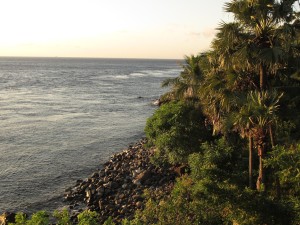
Current pools created by the Throughflow off the coast of the village of Aas on the very tip of Asia
Seasons have an effect on the speed of the Throughflow, with August usually the strongest month when the southeast monsoon is at its zenith. This also coincides with mola-mola season around Nusa Penida. The arrival of these bizarre creatures may be linked to the increased strength of the current but this time of year also sees an upwelling of colder water in the south of the Lombok Straits and that may be significant too. The reliability of mola-mola sightings during this period has created a small boom in the local diving industry. Be warned if you are thinking of joining the crowds: water temperatures can drop to the high teens centigrade but when you are face to face with an oceanic sunfish measuring four metres from tip to tail you will probably not even notice!
Blogs
Northern Red Sea Reefs and Wrecks Trip Report, Part 3: The Mighty Thistlegorm

Jake Davies boards Ghazala Explorer for an unforgettable Red Sea diving experience…
Overnight, the wind picked up, making the planned morning dive a bit bumpy on the Zodiacs to the drop point on Thomas Reef. There, we would dive along the reef before descending through the canyon and then passing under the arch before ascending the wall with a gentle drift. The site provided great encounters with more pelagic species, including shoals of large barracuda, tuna, and bigeye trevally.
Once back on the boat, it was time to get everything tied down again as we would head back south. This time, with the wind behind us, heading to Ras Mohammed to dive Jackfish Alley for another great gentle drift wall dive before then heading up the coast towards the Gulf of Suez to moor up at the wreck of the Thistlegorm. This being the highlight wreck dive of the trip and for many onboard, including myself, it was the first time diving this iconic wreck. I had heard so much about the wreck from friends, and globally, this is a must on any diver’s list. Fortunately for us, there was only one other boat at the site, which was a rarity. A great briefing was delivered by Ahmed, who provided a detailed background about the wreck’s history along with all the required safety information as the currents and visibility at the site can be variable.

Kitting up, there was a lot of excitement on deck before entering the water and heading down the shoreline. Descending to the wreck, there was a light northerly current which reduced the visibility, making it feel more like the conditions that can be found off the Welsh coast. At 10m from the bottom, the outline of the wreck appeared as we reached the area of the wreck which had been bombed, as our mooring line was attached to part of the propeller shaft. Arriving on deck, instantly everywhere you looked there were many of the supplies which the ship was carrying, including Bren Carrier tanks and projectiles that instantly stood out.

We headed around the exterior, taking a look at the large propeller and guns mounted on deck before entering the wreck on the port side to take a look in the holds. It was incredible to see all the trucks, Norton 16H, and BSA motorcycles still perfectly stacked within, providing a real snapshot in time.

Overall, we had four dives on the Thistlegorm, where for all of the dives we were the only group in the water, and at times, there were just three of us on the whole wreck, which made it even more special, especially knowing that most days the wreck has hundreds of divers. Along with the history of the wreck, there was plenty of marine life on the wreck and around, from big green turtles to batfish, along with shoals of mackerel being hunted by trevally. Some unforgettable dives.

The final leg of the trip saw us cross back over the Suez Canal to the Gobal Islands where we planned to stay the night and do three dives at the Dolphin House for the potential of sharing the dive with dolphins. The site, which included a channel that was teeming with reef fish, especially large numbers of goatfish that swam in large shoals along the edge of the reef. These were nice relaxing dives to end the week. Unfortunately, the dolphins didn’t show up, which was okay as like all marine life they are difficult to predict and you can’t guarantee what’s going to be seen. With the last dive complete, we headed back to port for the final night where it was time to clean all the kit and pack before the departure flight the next day.

The whole week from start to finish on Ghazala Explorer was amazing; the boat had all the facilities you need for a comfortable week aboard. The crew were always there to help throughout the day and the chefs providing top quality food which was required after every dive. The itinerary providing some of the best diving with a nice mixture of wreck and reef dives. I would recommend the trip to anyone, whether it’s your first Red Sea liveaboard in the Red Sea or you’re revisiting. Hopefully, it’s not too long before I head back to explore more of the Red Sea onboard Ghazala Explorer.

To find out more about the Northern Red Sea reef and wrecks itineraries aboard Ghazala Explorer, or to book, contact Scuba Travel now:
Email: dive@scubatravel.com
Tel: +44 (0)1483 411590
Photos: Jake Davies / Avalon.Red
Blogs
Northern Red Sea Reefs and Wrecks Trip Report, Part 2: Wall to Wall Wrecks

Jake Davies boards Ghazala Explorer for an unforgettable Red Sea diving experience…
The second day’s diving was a day full of wreck diving at Abu Nuhas, which included the Chrisoula K, Carnatic, and Ghiannis D. The first dive of the day was onto the Chrisoula K, also known as the wreck of tiles. The 98m vessel remains largely intact where she was loaded with tiles which can be seen throughout the hold. The stern sits at 26m and the bow just below the surface. One of the highlights of the wreck is heading inside and seeing the workroom where the machinery used for cutting the tiles are perfectly intact. The bow provided some relaxing scenery as the bright sunlight highlighted the colours of the soft coral reef and the many reef fish.

Following breakfast, we then headed to the next wreck, which was the Carnatic. The Carnatic is an 89.9m sail steamer vessel that was built in Britain back in 1862. She ran aground on the reef back in 1869 and remains at 27m. At the time, she was carrying a range of items, including 40,000 sterling in gold. An impressive wreck where much of the superstructure remains, and the two large masts lay on the seafloor. The wooden ribs of the hull provide structures for lots of soft corals, and into the stern section, the light beams through, bouncing off the large shoals of glass fish that can be found using the structure as shelter from the larger predators that are found outside of the wreck.

The final wreck at Abu Nuhas was the Ghiannis D, originally called ‘Shoyo Maru,’ which was 99.5m long and built in Japan back in 1969 before becoming a Greek-registered cargo ship in 1980. The ship then ran aground on the reef on April 19th, 1983, and now sits at the bottom at a depth of 27m. Heading down the line, the stern of the ship remains in good condition compared to the rest of the hull. The highlight of the wreck, though, is heading into the stern section and down the flights of stairs to enter the engine room, which remains in good condition and is definitely worth exploring. After exploring the interior section of the ship, we then headed over to see the rest of the superstructure, where it’s particularly interesting to see the large table corals that have grown at the bow relatively quickly considering the date the ship sank. After surfacing and enjoying some afternoon snacks, we made sure everything was strapped down and secured as we would be heading north and crossing the Gulf of Suez, where the winds were still creating plenty of chop.

The next morning, it was a short hop to Ras Mohammed Nature Reserve for the next couple of days of diving. The 6am wake-up call came along with the briefing for the first site we would be diving, which was Shark & Yolanda. The low current conditions allowed us to start the dive at Anemone City, where we would drift along the steep, coral-filled wall. These dives involved drifts, as mooring in Ras Mohammed wasn’t allowed to protect the reefs. As a dive site, Shark & Yolanda is well-known and historically had a lot of sharks, but unfortunately not so many in recent years, especially not so early in the season. However, there was always a chance when looking out into the blue.

The gentle drift took us along the steep walls of the site, with plenty of anemone fish to be seen and a huge variety of corals. It wasn’t long into the dive before we were accompanied by a hawksbill turtle, who drifted with us between the two atolls before parting ways. Between the two reefs, the shallow patch with parts of coral heads surrounded by sand provided the chance to see a few blue-spotted stingrays that were mainly resting underneath the corals and are always a pleasure to see. With this being the morning dive, the early sunlight lit up the walls, providing tranquil moments. Looking out into the blue, there was very little to be seen, but a small shoal of batfish shimmering underneath the sunlight was a moment to capture as we watched them swim by as they watched us.

Towards the end of the dive, we stopped at the wreck of the Jolanda where the seafloor was scattered with toilets from the containers it was carrying. This provided a unique site to make a safety stop, which was also accompanied by a large barracuda slowly swimming by, along with a hawksbill turtle calmly swimming over the reef as the sun rays danced in the distance.
For the next dive, we headed north to the Strait of Tiran to explore the reefs situated between Tiran Island and Sharm El Sheik, which were named after the British divers who had found them. We started on Jackson before heading to Gordons Reef, where we also did the night dive. All the atolls at these sites provided stunning, bustling coral reefs close to the surface and steep walls to swim along, which always provided the opportunity to keep an eye out for some of the larger species that can be seen in the blue. Midwater around Jackson Reef was filled with red-toothed triggerfish and shoals of banner fish, which at times were so dense that you couldn’t see into the blue. Moments went by peacefully as we enjoyed the slow drift above the reef, watching these shoals swim around under the mid-afternoon sun.

The night dive at Gordon’s Reef was mainly among the stacks of corals surrounded by sand, which was great to explore under the darkness. After some time circling the corals, we came across what we were really hoping to find, and that was an octopus hunting on the reef. We spent the majority of the dive just watching it crawl among the reef, blending into its changing surroundings through changes in colour and skin texture. It’s always so fascinating and captivating to watch these incredibly intelligent animals, in awe of their ability to carry out these physical changes to perfectly blend into the reef. Before we knew it, it was time to head back to the boat to enjoy a well-deserved tasty dinner prepared by the talented chefs onboard.
Check in for the 3rd and final part of this series from Jake tomorrow!
To find out more about the Northern Red Sea reef and wrecks itineraries aboard Ghazala Explorer, or to book, contact Scuba Travel now:
Email: dive@scubatravel.com
Tel: +44 (0)1483 411590
Photos: Jake Davies / Avalon.Red
-

 News3 months ago
News3 months agoHone your underwater photography skills with Alphamarine Photography at Red Sea Diving Safari in March
-

 News3 months ago
News3 months agoCapturing Critters in Lembeh Underwater Photography Workshop 2024: Event Roundup
-

 Marine Life & Conservation Blogs3 months ago
Marine Life & Conservation Blogs3 months agoCreature Feature: Swell Sharks
-

 Blogs2 months ago
Blogs2 months agoMurex Resorts: Passport to Paradise!
-

 Blogs2 months ago
Blogs2 months agoDiver Discovering Whale Skeletons Beneath Ice Judged World’s Best Underwater Photograph
-

 Marine Life & Conservation2 months ago
Marine Life & Conservation2 months agoSave the Manatee Club launches brand new webcams at Silver Springs State Park, Florida
-

 Gear Reviews3 months ago
Gear Reviews3 months agoGear Review: Oceanic+ Dive Housing for iPhone
-

 Gear Reviews2 weeks ago
Gear Reviews2 weeks agoGEAR REVIEW – Revolutionising Diving Comfort: The Sharkskin T2 Chillproof Suit


